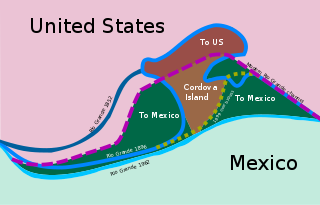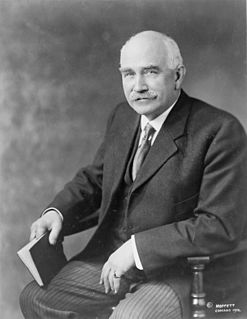Related Research Articles

Sovereignty is the defining authority within an individual consciousness, social construct or territory. Sovereignty entails hierarchy within the state, as well as external autonomy for states. In any state, sovereignty is assigned to the person, body, or institution that has the ultimate authority over other people in order to establish a law or change an existing law. In political theory, sovereignty is a substantive term designating supreme legitimate authority over some polity. In international law, sovereignty is the exercise of power by a state. De jure sovereignty refers to the legal right to do so; de facto sovereignty refers to the factual ability to do so. This can become an issue of special concern upon the failure of the usual expectation that de jure and de facto sovereignty exist at the place and time of concern, and reside within the same organization.

The United Nations Convention on the Law of the Sea (UNCLOS), also called the Law of the Sea Convention or the Law of the Sea Treaty, is an international agreement that establishes a legal framework for all marine and maritime activities. As of June 2016, 167 countries and the European Union are parties.

The Rio Grande, known in Mexico as the Río Bravo del Norte or simply the Río Bravo, is one of the principal rivers in the southwestern United States and in northern Mexico. The length of the Rio Grande is 1,896 miles (3,051 km). It originates in south-central Colorado, in the United States, and flows to the Gulf of Mexico. The Rio Grande drainage basin (watershed) has an area of 182,200 square miles (472,000 km2); however, the endorheic basins that are adjacent to and within the greater drainage basin of the Rio Grande increase the total drainage-basin area to 336,000 square miles (870,000 km2).
A territorial dispute or boundary dispute is a disagreement over the possession or control of land between two or more political entities.

The terms international waters or trans-boundary waters apply where any of the following types of bodies of water transcend international boundaries: oceans, large marine ecosystems, enclosed or semi-enclosed regional seas and estuaries, rivers, lakes, groundwater systems (aquifers), and wetlands.

Freedom of the seas is a principle in the international law and sea. It stresses freedom to navigate the oceans. It also disapproves of war fought in water. The freedom is to be breached only in a necessary international agreement.

An acequia or séquia is a community-operated watercourse used in Spain and former Spanish colonies in the Americas for irrigation. Particularly in Spain, the Andes, northern Mexico, and the modern-day American Southwest particularly northern New Mexico and southern Colorado, acequias are usually historically engineered canals that carry snow runoff or river water to distant fields. Examples of acequias in New Mexico have lengthy historical roots to Pueblo and Hispano communities, and they are incorporated into traditions including the matachines, life in the Rio Grande Bosque of the Albuquerque metropolitan area, and pilgrimages to El Santuario de Chimayo.

The Chamizal dispute was a border conflict over around 600 acres (2.4 km2) on the Mexico–United States border between El Paso, Texas, and Ciudad Juárez, Chihuahua. It was caused by a shift in the Rio Grande, as a survey presented in 1852 marked differences between the bed of the Rio Grande and the present channel of the river. Tensions over the territory during the historic Taft–Diaz summit almost resulted in the attempted assassination of both presidents on October 16, 1909.

Water resources law is the field of law dealing with the ownership, control, and use of water as a resource. It is most closely related to property law, and is distinct from laws governing water quality.

Judson Harmon was an American Democratic politician from Ohio. He served as United States Attorney General under President Grover Cleveland and later served as the 45th governor of Ohio.

An exclusive economic zone (EEZ), as prescribed by the 1982 United Nations Convention on the Law of the Sea, is an area of the sea in which a sovereign state has special rights regarding the exploration and use of marine resources, including energy production from water and wind. It stretches from the outer limit of the territorial sea out to 200 nautical miles (nmi) from the coast of the state in question. It is also referred to as a maritime continental margin and, in colloquial usage, may include the continental shelf. The term does not include either the territorial sea or the continental shelf beyond the 200 nautical mile limit. The difference between the territorial sea and the exclusive economic zone is that the first confers full sovereignty over the waters, whereas the second is merely a "sovereign right" which refers to the coastal state's rights below the surface of the sea. The surface waters, as can be seen in the map, are international waters.
Prior appropriation: In water rights, the legal doctrine of prior appropriation holds that the first person to take a quantity of water from a water source for "beneficial use" has the right to continue to use that quantity of water for that purpose. 78 Am. Jur. 2d Waters § 355 (2021). These individuals are the senior users. Senior users do not "own" the water source. Rather, they have the right to use the water source within the limitations of a state's established prior appropriation laws.Douglas County v. Sedalia Water and Sanitation District, 343 P.3d 16.
Water right in water law refers to the right of a user to use water from a water source, e.g., a river, stream, pond or source of groundwater. In areas with plentiful water and few users, such systems are generally not complicated or contentious. In other areas, especially arid areas where irrigation is practiced, such systems are often the source of conflict, both legal and physical. Some systems treat surface water and ground water in the same manner, while others use different principles for each.

The International Boundary and Water Commission is an international body created by the United States and Mexico in 1889 to apply the rules for determining the location of their international boundary when meandering rivers transferred tracts of land from one bank to the other, as established under the Convention of November 12, 1884.

The Mexico–United States border is an international border separating Mexico and the United States, extending from the Pacific Ocean in the west to the Gulf of Mexico in the east. The border traverses a variety of terrains, ranging from urban areas to deserts. The Mexico–United States border is the most frequently crossed border in the world, with approximately 350 million documented crossings annually. It is the tenth-longest border between two countries in the world.
The Estrada Doctrine is the name of Mexico's core foreign policy ideal from 1930 to the early 2000s, and again since 2018. Its name derives from Genaro Estrada, Secretary of Foreign Affairs during the presidency of Pascual Ortiz Rubio (1930–1932).

The Preamble of the Constitution of India presents the principles of the Constitution and indicates the sources of its authority It was adopted on 26 November 1949 by the Constituent Assembly and came into effect on 26 January 1950, celebrated as the Republic day of India.
The Convention on the Law of Non-Navigational Uses of International Watercourses, commonly referred to as the UN Watercourses Convention, is an international treaty, adopted by the United Nations on 21 May 1997, pertaining to the uses and conservation of all waters that cross international boundaries, including both surface and groundwater. "Mindful of increasing demands for water and the impact of human behavior", the UN drafted the document to help conserve and manage water resources for present and future generations. From the time of its drafting, the Convention took more than 17 years to enter into force on 17 August 2014. With the treaty having been ratified by just 36 states, the majority of countries, especially the key ones, remain outside its scope. The convention, however, is regarded as an important step in establishing international law governing water.
The Helsinki Rules on the Uses of the Waters of International Rivers is an international guideline regulating how rivers and their connected groundwaters that cross national boundaries may be used, adopted by the International Law Association (ILA) in Helsinki, Finland in August 1966. In spite of its adoption by the ILA, there is no mechanism in place that enforces the rules. Notwithstanding the guideline's lack of formal status, its work on rules governing international rivers was pioneering. It led to the creation of the United Nations' Convention on the Law of Non-Navigational Uses of International Watercourses. In 2004, it was superseded by the Berlin Rules on Water Resources.

The Israeli Peace Initiative is a compromise plan given by the political left within Israel in response to the Arab Peace Initiative issued by the Arab League in 2002 and again in 2007. It was released on April 6, 2011. It compromises with the Palestinians in an effort to establish peace in Israel. One of the key differences from other peace plans is that the Israeli Peace Initiative proposes a complete withdrawal of Israeli forces from the Gaza Strip and the West Bank. It also calls for the establishment of the Temple Mount as neutral ground between Palestine and Israel, and the retention of the Jewish Quarter of the Old City within Israel. Additionally, the peace plan addresses Israel's relations with its Arab neighbors, including settling the dispute over the Golan Heights, territory that Israel captured from Syria in the Six-Day War.
References
- 1 2 Stephen C. McCaffrey (1996). The Harmon Doctrine One Hundred Years Later: Buried, Not Praised, 36 Nat. Resources J. 965.
- ↑ "Harmon doctrine". United Nations Economic and Social Commission for Western Asia. Retrieved 2020-12-12.
{{cite web}}: CS1 maint: url-status (link) - ↑ "Part 2. Article 5. (5.1.1) Theories of allocation". UN Watercourses Convention. Retrieved 2020-12-12.
{{cite web}}: CS1 maint: url-status (link) - ↑ Rahaman, M.M. (2009) 'Principles of international water law: creating effective transboundary water resources management', Int. J. Sustainable Society, Vol. 1, No. 3, pp.207–223.